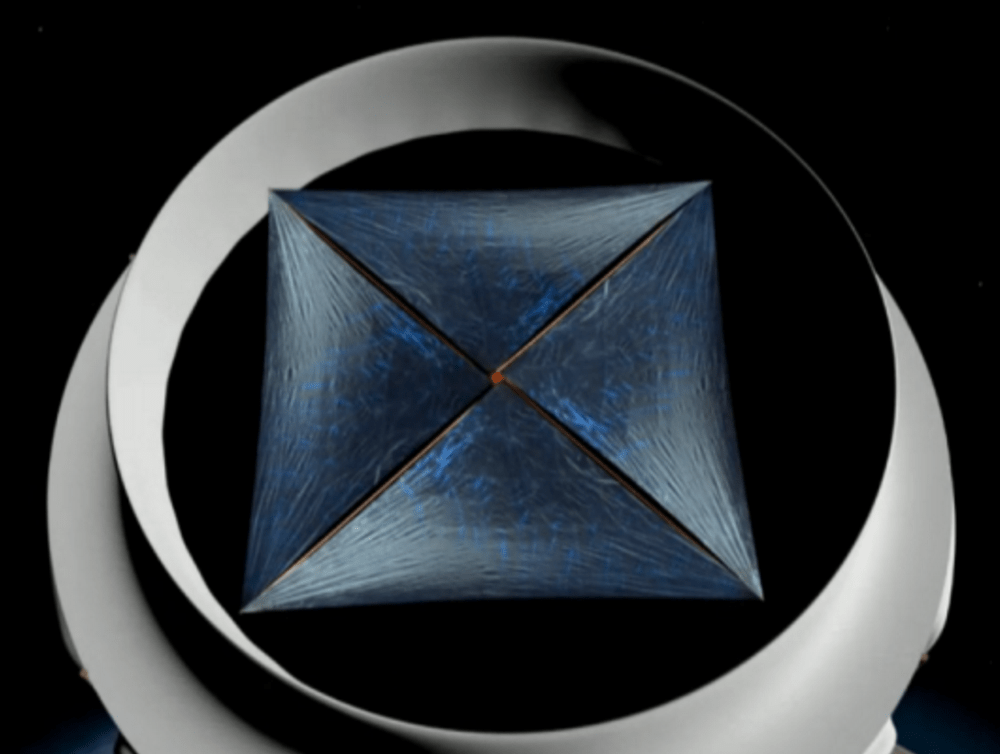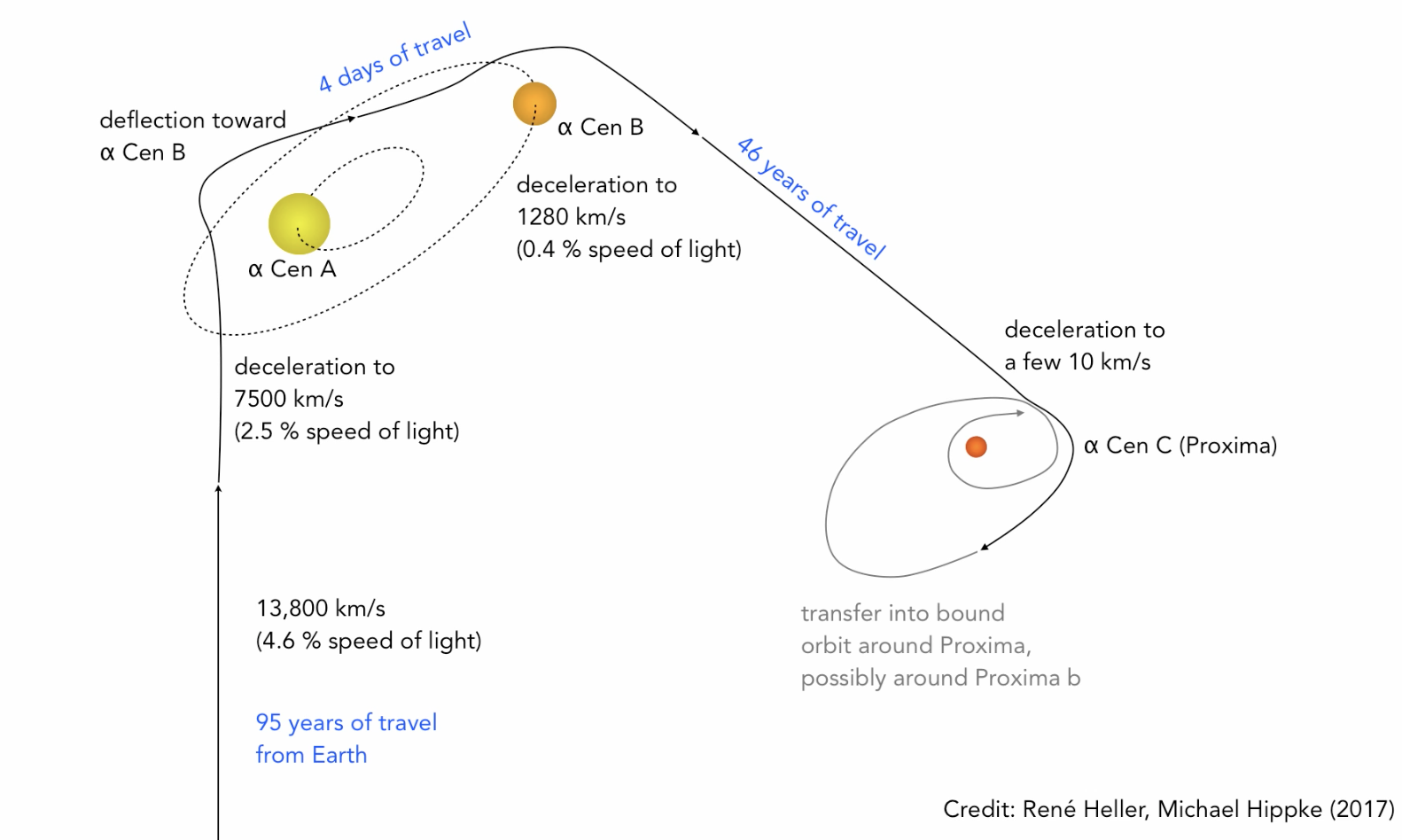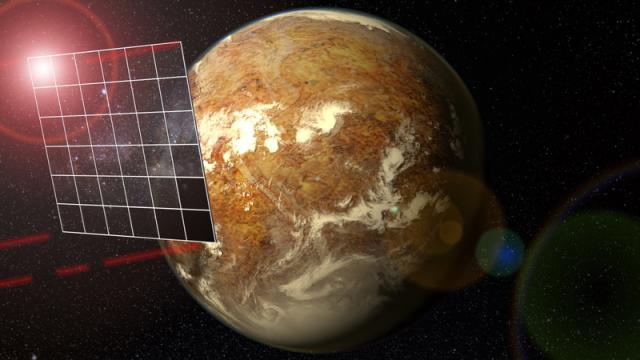Last year, Stephen Hawking and Russian billionaire Yuri Milner hatched an ambitious plan to send a tiny probe to the Alpha Centauri star system. Travelling at 20 per cent the speed of light, the researchers weren’t entirely sure how the probe was supposed to stop once it arrived at its destination, or whether it would even be able to. Excitingly, a pair of European scientists now say they have solved the problem.
In a new paper published in The Astrophysical Journal Letters, physicist René Heller from the Max Planck Institute, along with computer scientist Michael Hippke, has shown that the radiation and gravity from Alpha Centauri’s stars can be used to decelerate an incoming probe. So instead of whizzing by in a flash, the lightsail-driven nanocraft will hit the brakes, slowing down enough to explore the system’s trio of stars — and even the Earth-like planet Proxima b.
As part of the Breakthrough Starshot Initiative, Milner plans to invest $US100 million ($132 million) in an effort to develop an ultra-light autonomous lightsail that can be accelerated to one-fifth the speed of light (60,000km/s). At this ludicrous speed, a sail-driven robotic probe could reach Alpha Centauri — the closest star system to Earth — in just 20 years, as opposed to 100,000 years using traditional chemical thrusters.
Under the original proposal, a tiny probe would be mounted to a small, metre-sized light sail, and driven away from Earth by a phased array of lasers. The energy produced by the lasers could theoretically accelerate an object thousands of times faster than the fastest spacecraft today.

But this isn’t the only scheme being considered. Under Heller and Hippke’s plan, a much larger “photon” sail would replace the laser array. The probe itself would measure a several centimetres across and weigh just a few grams (sorry, no passengers on this trip!). To propel it through interstellar space, the device would be attached to large, square-shaped sails. In addition to being big, the sails would need to be exceptionally light, and thus very thin. Radiation emanating away from the Sun would push the probe in the direction of Alpha Centauri. Once enough gravitational inertia is acquired, the probe would retract its sails for the long journey ahead.
Under this scheme, it would take the probe about 95 years travelling at 4.6 per cent the speed of light to reach Alpha Centauri. It’s nearly five-times longer than Milner’s original timeframe — but excitingly, the probe could theoretically be made to stop.
“Interstellar travel to the Alpha Centauri system will supposedly happen with speeds that are a significant fraction of the speed of light in order to keep travel times well below 1000 or, better, even below 100 years,” Heller told Gizmodo. “At that speed, however, an incoming lightsail would need extremely high amounts of energy to slow down [and enter] bound orbits.” Adding fuel for deceleration, he says, would only make matters worse. “If the ship has the required fuel on board, then it would be very heavy — increasing its needs for even more fuel.”
Given this limitation, and without a solution, it was assumed that the probes would zoom past the Alpha Centauri system similarly to how the New Horizons flew past Pluto. But at near relativistic speeds, the probe would likely experience great difficulty taking accurate and meaningful measurements of the star system itself. Thankfully, however, there may be a solution — one that would not just slow down the nanocraft to more manageable speeds, but allow mission scientists to explore the Alpha Centauri system in great detail.
“We found a method to slow down incoming light sails using the energy output of the target star instead,” said Heller. “We use the energy of the stellar light particles to slow down the sail. Hence, the incoming light sail would need no onboard fuel, which nicely fits the scenario of an interstellar, extremely-light sail proposed by the Breakthrough Starshot Initiative.”
Above: An animation showing the “photogravitational assist” at Alpha Centauri A.
For this plan to work, the probe would redeploy its sail on arrival, leveraging the incoming radiation from the stars in the Alpha Centauri system. Using a computer simulation, Heller and Hippke based their calculations on a 100g space probe attached to a 100,000-square-metre sail, which is about the size of 14 soccer fields. As the probe gets increasingly close to the star system, the braking force increases.
On arrival, instead of using solar photons as a propulsion force, the sail “catches” the outgoing solar radiation from Alpha Centauri, gradually slowing the vehicle down. Ironically, the same physics that will push the probe away from our solar system will be used to slow it down at its destination.
During the deceleration manoeuvre, the tiny probe will need to approach the star Alpha Centauri A to within five stellar radii (that is, a distance equal to five times the width of the star), or about four million km, in order to be captured into orbit. By this point, the nanocraft will have slowed down to about 2.5 per cent the speed of light. Failure to slow the craft down from its maximum cruising speed (4.6 per cent the speed of light) would fling the probe away and back into interstellar space.

Every successful journey starts with a map. This one shows the manoeuvring of the autonomous “nanocraft” as it decelerates at Alpha Centauri A, makes a quick four-day journey to Alpha Centauri B, and finally proceeding on a 46-year trip to Proxima Centauri — home of an Earth-like planet.
Once at Alpha Centauri A, the star’s gravity can be used to manoeuvre the probe, similar to the “slingshot” manoeuvres used to direct probes like Voyagers 1 and 2 around the solar system. Theoretically, the autonomous probe could settle into an orbit around Alpha Centauri A and explore its planets. Excitingly, Heller and Hippke have also outlined a plan for sending the probe to the system’s other stars, namely Alpha Centauri B (the binary companion to Alpha Centauri A) and Proxima Centauri (a distant third star located about 0.22 light-years (two trillion km) from A and B’s common centre of mass). Under this plan, it would take the probe about a century to reach Alpha Centauri A, a few days to reach Alpha Centauri B and then another 46 years to reach Proxima Centauri.
But the added years would be worth it. In one of the most remarkable discoveries of 2016, astronomers learned that Proxima Centauri hosts an Earth-like planet. It’s one of the most tantalising objects of inquiry within striking distance — and we finally have a plan for observing it up close. Data collected by the probe would take a little over four years to reach mission scientists on Earth (given the extreme distances involved, we’re going to have be patient with such things, and get accustomed to such long term planning/thinking). A system for sending the data back still needs to be developed.
A battery of technical hurdles still need to be sorted out before such a mission is launched, but the researchers are optimistic. For example, some of the super-light materials required for the mission have already been produced in the lab. “We might need one or two decades to be able to build such interstellar light sails,” Heller told Gizmodo. He adds that the sail’s surface would need to be very reflective from the red to the blue part of the visible spectrum, and possibly even beyond that. “This technology is not yet available but, again, huge progress has been made in laboratories over the past few years and scientists have found… materials that can reflect up to 99.99% the amount of light that they receive.”
Next, Heller and Hippke plan to present their study in detail to the Breakthrough Starshot Initiative at its upcoming Breakthrough Discuss meeting in Palo Alto in April.
“We are very interested in their feedback, because these people are the world’s leading experts in this emerging field of interstellar light sail research,” he said. “Then, Michael [Hippke] and I are working out ideas for an interstellar travel catalogue to our most nearby stars, but this is work in progress and mostly confidential between Michael and me so far.”
Ooooh, such a tease. As always, Gizmodo will be on the lookout for when this research is made public. Until then, let’s celebrate the fact that we’re a step closer to embarking on humanity’s first interstellar space mission.
